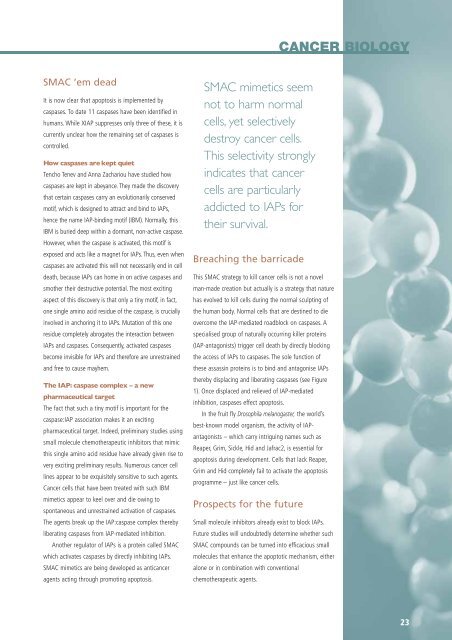Joint Annual Research Report 2004 - The Royal Marsden
Joint Annual Research Report 2004 - The Royal Marsden
Joint Annual Research Report 2004 - The Royal Marsden
You also want an ePaper? Increase the reach of your titles
YUMPU automatically turns print PDFs into web optimized ePapers that Google loves.
CANCER BIOLOGY<br />
SMAC ’em dead<br />
It is now clear that apoptosis is implemented by<br />
caspases. To date 11 caspases have been identified in<br />
humans. While XIAP suppresses only three of these, it is<br />
currently unclear how the remaining set of caspases is<br />
controlled.<br />
How caspases are kept quiet<br />
Tencho Tenev and Anna Zachariou have studied how<br />
caspases are kept in abeyance. <strong>The</strong>y made the discovery<br />
that certain caspases carry an evolutionarily conserved<br />
motif, which is designed to attract and bind to IAPs,<br />
hence the name IAP-binding motif (IBM). Normally, this<br />
IBM is buried deep within a dormant, non-active caspase.<br />
However, when the caspase is activated, this motif is<br />
exposed and acts like a magnet for IAPs. Thus, even when<br />
caspases are activated this will not necessarily end in cell<br />
death, because IAPs can home in on active caspases and<br />
smother their destructive potential. <strong>The</strong> most exciting<br />
aspect of this discovery is that only a tiny motif, in fact,<br />
one single amino acid residue of the caspase, is crucially<br />
involved in anchoring it to IAPs. Mutation of this one<br />
residue completely abrogates the interaction between<br />
IAPs and caspases. Consequently, activated caspases<br />
become invisible for IAPs and therefore are unrestrained<br />
and free to cause mayhem.<br />
<strong>The</strong> IAP: caspase complex – a new<br />
pharmaceutical target<br />
<strong>The</strong> fact that such a tiny motif is important for the<br />
caspase:IAP association makes it an exciting<br />
pharmaceutical target. Indeed, preliminary studies using<br />
small molecule chemotherapeutic inhibitors that mimic<br />
this single amino acid residue have already given rise to<br />
very exciting preliminary results. Numerous cancer cell<br />
lines appear to be exquisitely sensitive to such agents.<br />
Cancer cells that have been treated with such IBM<br />
mimetics appear to keel over and die owing to<br />
spontaneous and unrestrained activation of caspases.<br />
<strong>The</strong> agents break up the IAP:caspase complex thereby<br />
liberating caspases from IAP-mediated inhibition.<br />
Another regulator of IAPs is a protein called SMAC<br />
which activates caspases by directly inhibiting IAPs.<br />
SMAC mimetics are being developed as anticancer<br />
agents acting through promoting apoptosis.<br />
SMAC mimetics seem<br />
not to harm normal<br />
cells, yet selectively<br />
destroy cancer cells.<br />
This selectivity strongly<br />
indicates that cancer<br />
cells are particularly<br />
addicted to IAPs for<br />
their survival.<br />
Breaching the barricade<br />
This SMAC strategy to kill cancer cells is not a novel<br />
man-made creation but actually is a strategy that nature<br />
has evolved to kill cells during the normal sculpting of<br />
the human body. Normal cells that are destined to die<br />
overcome the IAP-mediated roadblock on caspases. A<br />
specialised group of naturally occurring killer proteins<br />
(IAP-antagonists) trigger cell death by directly blocking<br />
the access of IAPs to caspases. <strong>The</strong> sole function of<br />
these assassin proteins is to bind and antagonise IAPs<br />
thereby displacing and liberating caspases (see Figure<br />
1). Once displaced and relieved of IAP-mediated<br />
inhibition, caspases effect apoptosis.<br />
In the fruit fly Drosophila melanogaster, the world’s<br />
best-known model organism, the activity of IAPantagonists<br />
– which carry intriguing names such as<br />
Reaper, Grim, Sickle, Hid and Jafrac2, is essential for<br />
apoptosis during development. Cells that lack Reaper,<br />
Grim and Hid completely fail to activate the apoptosis<br />
programme – just like cancer cells.<br />
Prospects for the future<br />
Small molecule inhibitors already exist to block IAPs.<br />
Future studies will undoubtedly determine whether such<br />
SMAC compounds can be turned into efficacious small<br />
molecules that enhance the apoptotic mechanism, either<br />
alone or in combination with conventional<br />
chemotherapeutic agents.<br />
23

















